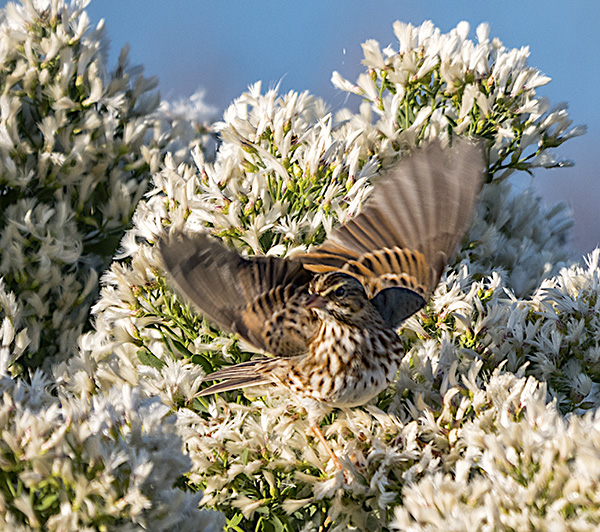
by successfulbob | bird photography, Lumix G9, photography, photography gear, travel photography, wildlife photography
Bombay Hook National Wildlife Refuge – Smyrna, Delaware
I’ve been a bit remiss in posting. Travel for speaking. Travel for family visit. And catching up upon return fronfrom the travel makes Bob a bad boy. But, I’m back and with plans to have more posts even when traveling to judge images &speak in Oregon and do a seminar and a couple workshops for the Festival of the Cranes in Socorro, New Mexico in the middle of November. We’ll see how that works out!
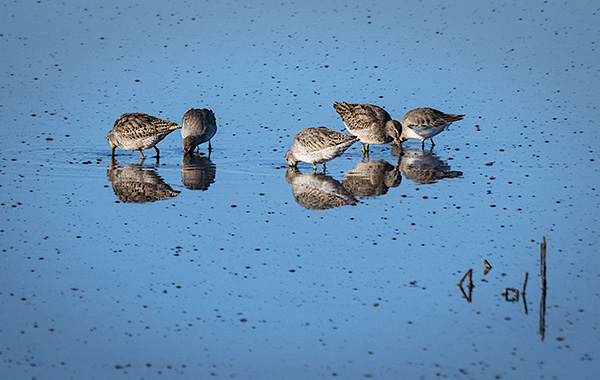 Dunlin Sandpipers enjoying breakfast
Dunlin Sandpipers enjoying breakfast
While on the family visit I made it up to the Bombay Hook National Wildlife Refuge. I spent the day making images and talking photography with my friend Ned Levi. This was the first time we met in person. I highly recommend spending quality time with your peers. It’s wonderful how much you can learn from each other. (learn more about Ned and his blog)
 Thought this was an interesting formation of the Canada Geese. I normally enjoy them mor eisolatedbut the overlap of the birds is kida cool. Watcha’ think??
Thought this was an interesting formation of the Canada Geese. I normally enjoy them mor eisolatedbut the overlap of the birds is kida cool. Watcha’ think??
If you have not spent time in wildlife refuges there are some protocols that make the system work for everyone. If you do go please follow the rules and regs. use the longest lens you have and do your best to not disturb the wildlife. There’s an expression, “Take only images, leave only footprints.” Not sure I have the exact words but you understand the sentiment.
This is from the Refuge website and the rules are much the same in all refuges.
Know Before You Go
- The wildlife drive is open from 1/2 hour before sunrise to 1/2 hour after sunset daily.
- The visitor center is open weekdays from 8:00 a.m. to 4:00 p.m. year round.
- During spring and fall weekends, the visitor center is open Saturday and Sunday from 9:00 a.m. to 5:00 p.m.
- The visitor center is handicapped accessible and has educational displays and videos.
- The visitor center is closed on Federal Holidays.
- The visitor center is closed on weekends during July, August, mid-December, January, and February.
- Check the website or call to find out about refuge road closures during bad weather and hunting season. During summer months, visitor should bring insect repellent and wear long-sleeve shirts and long pants.
- To protect wildlife and their habitat and to provide the best opportunities in wildlife observation and photography, it is important not to disturb, injure, or damage plants and animals on the refuge. In fact, it is a prohibited act as stated in 50 CFR 27.51. This disturbance includes flushing birds and other wildlife or using mechanical or electronic devices to lure birds closer for observation or photography. Please remember to take only memories and photographs and leave only footprints.
- Unmanned aircraft systems (Drones) are prohibited.
 A simple houe wren was dancing in and out of the flowering bush. Behavior and movement photos are my aim.
A simple houe wren was dancing in and out of the flowering bush. Behavior and movement photos are my aim.
Images were made with the PANASONIC LUMIX G Leica DG Vario-Elmar Professional Lens, 100-400MM, F4.0-6.3 ASPH mounted on the Lumix G9.
Yours in Creative Photography, bob
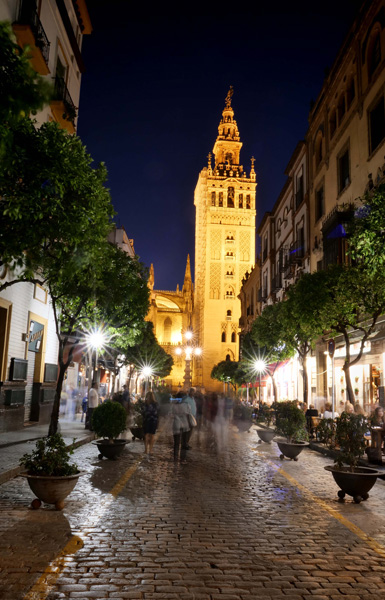
by successfulbob | architectural photography, Guest Post, Lumix G9, travel photography
Seville, Spain – Travel with Ken MacAdams Part Three
A few blocks away from the Alcazar is the Hospital de la Caridad, a 17th-century charity hospital which served as a place of final refuge for Sevilla’s poor and homeless. The hospice and hospital were founded in 1626 by Don Miguel Manara, a one-time playboy who in later life had a change of heart and spent his last years dedicating his life to strict worship and taking care of the poor.
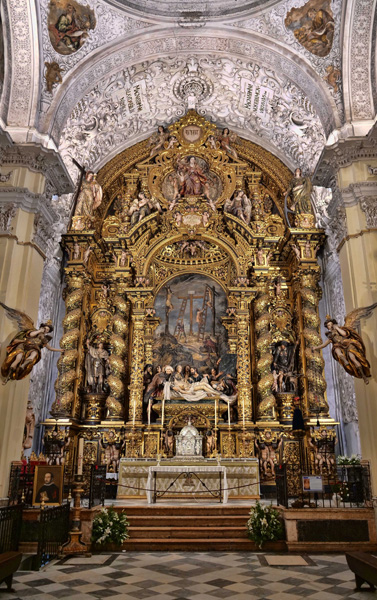 This was the “small” chapel at the Hospital de la Caridad. Statues, period artwork, and Dutch tile scenes graced the courtyards of the hospital.
This was the “small” chapel at the Hospital de la Caridad. Statues, period artwork, and Dutch tile scenes graced the courtyards of the hospital.
Inside you’ll find Italian statues (his wealthy family was from Italy) and Dutch tiles from Delft, depicting scenes from the Old and New Testament, a reminder that the Netherlands was under Spanish rule in centuries past.
Walk a few crooked blocks, and you’ll find yourself at the Plaza de Toros, or the bullfighting ring and museum. Guided tours take you through the empty arena, its museum, and the chapel where the matadors pray before the fight. Bullfighting still takes place here from May to September. Novice bullfighters take the ring on Thursday evenings in July. Serious bullfighters, the professionals, fight on special events and holidays, and these events often sell out in advance.

A handheld (no tripods allowed) shot of a Flamengo dancer at a sold-out performance along one of the back streets in the Jewish Quarter, adjacent to the Alcazar area.
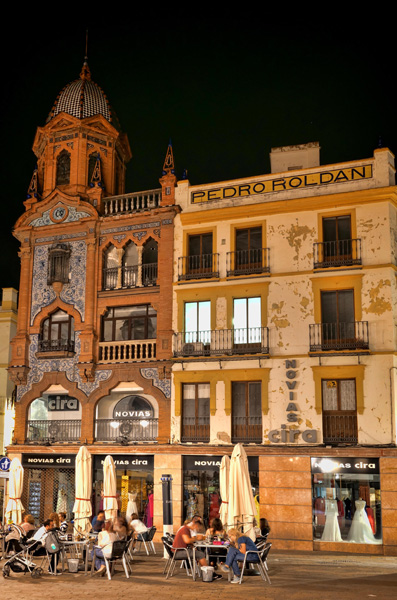
A typical street cafe and tapas bar scene. Note the inlaid tile work on the building on the left.
Flamenco, the dance that embodies the spirit of southern Spain, can be found in numerous locations and barrios nightly. Some of the establishments offer flamenco lessons, while others house exhibits of flamenco costumes and other artifacts.
A part of any visit to Seville is sampling the cuisine. Some feel the time spent sitting at an outdoor street cafe, savoring tapas and a bottle of wine, is as important as visiting the great city sights! Tapas are small portions of seafood, salads, meat-filled pastries, and other delicious bites. Tapas bars can be found in all areas of the city, and every local has their favorite!

Twenty-five-second nighttime exposure of the Giralda Bell Tower, a stunning landmark of Sevilla.
Oozing with Old World Charm, Seville is a destination in Spain not to be missed. Allow two days to see the main sights, and linger longer if possible! When you’re finished, head on to Andalucia’s White Hill Towns for your next over-the-top Spanish experience!
Ken has always loved to travel, so when he made a common connection with the fact that either a long day pounding the streets of some foreign city, or shooting the last dance at a wedding, a good part of his physical

weariness came from lugging around his big heavy DSLR. That’s when he started looking at alternatives – and ended up selecting Panasonic Lumix Micro Four Thirds gear.
Ken is rarely without a camera, and the next great photo travel experience – whether local or abroad – is always in the back of his mind! A longtime resident of the Four Corners, and when he’s not out on the road, he enjoys some of the great outdoor opportunities found there – mountain biking, hiking, and Jeeping.
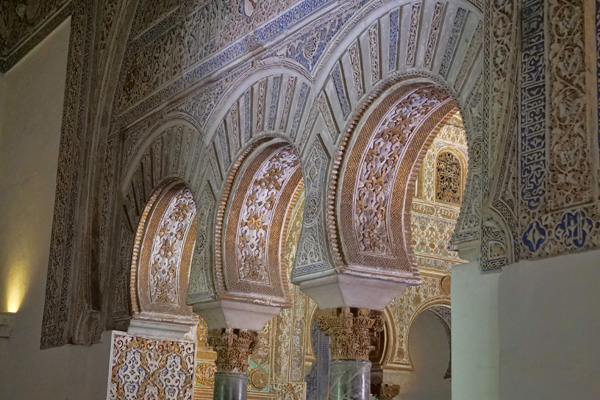
by successfulbob | architectural photography, Guest Post, Lumix G9, travel photography
Seville, Spain – Travel with Ken MacAdams Part Two
No visit to Seville is complete without a visit to the Royal Alcazar. Originally a 10th-century palace for the governors of the local Moorish state, this is Europe’s oldest still in use palace. Rebuilt in the 14th century by the Christian king Pedro I (by Muslim workmen), it features spectacularly decorated halls, courtyards, and gardens.
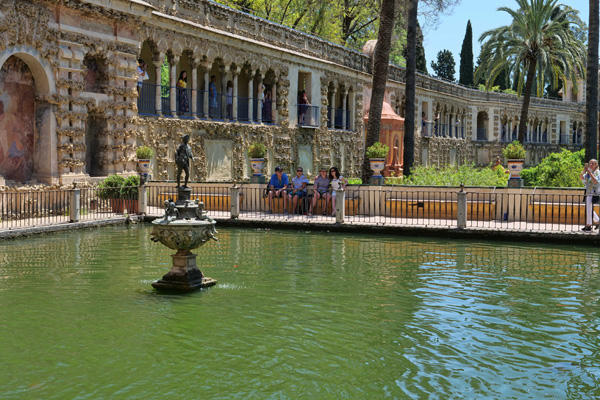
In the Garden Pool was a small statue of Mercury. This pool was fed by a 16th-century aqueduct.
There are distinctive Islamic-style flourishes seen in the archways, walls, and ceilings. As you enter, you’ll pass a rough stone wall, remnants of an older Moorish fortress, circa A.D. 913.
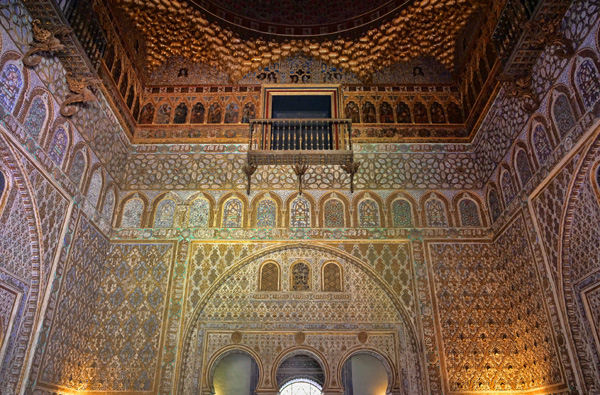
This image shows the painstaking attention to detail recorded on the walls and ceiling of the Hall of Ambassadors. All photos in this post © Ken MacAdams
In the Admiral’s Hall, Columbus recounted his travels, and Ferdinand Magellan planned his around-the-world venture. Queen Isabella realized Columbus’s New World discoveries could be big business. Here resides a model of Columbus’ flagship, the Santa Maria. In the center of King Pedro’s palace is the Courtyard of the Maidens, a big courtyard with a long pool in the center.

The Moorish doorways were left intact by the Reconquista Christians. Note the intricate detail in each arch.
Feeling his Alcazar a bit stark, the king hired Muslim workers from Granada – home to the famed Alhambra – to recreate its romance. This palace is considered by some as Spain’s best example of the Mudejar style. Subsequent kings, Philip II, and Charles V added their touches throughout the palace.
Seville, Spain part three Next Friday.
Ken has always loved to travel, so when he made a common connection with the fact that either a long day pounding the streets of some foreign city, or shooting the last dance at a wedding, a good part of his physical

weariness came from lugging around his big heavy DSLR. That’s when he started looking at alternatives – and ended up selecting Panasonic Lumix Micro Four Thirds gear.
Ken is rarely without a camera, and the next great photo travel experience – whether local or abroad – is always in the back of his mind! A longtime resident of the Four Corners, and when he’s not out on the road, he enjoys some of the great outdoor opportunities found there – mountain biking, hiking, and Jeeping.
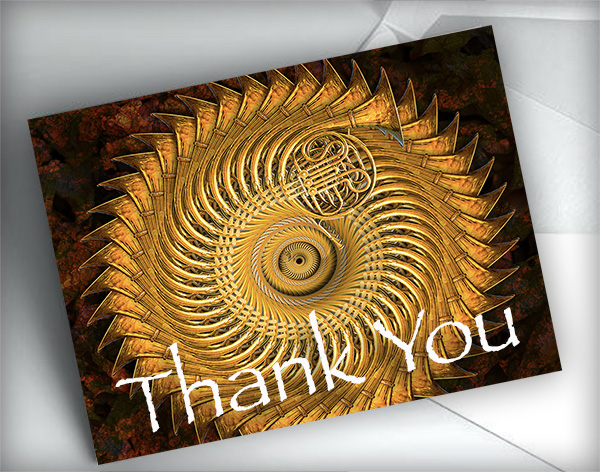
by successfulbob | Guest Post, Marketing Monday, photography education, photography marketing
The Power of a Handwritten Note
Marketing Monday with Skip Cohen
One of the easiest ways to separate yourself from the competition is also one of the most forgotten, a handwritten note. Most of us can barely write a check without making a mistake, simply because we’re so used to typing and texting everything we write.
Over the years I’ve sent hand-written notes and received some great ones. Each one has stood out in a different way and brought me closer to people, even some who I’ve known for many years. There are new friends and old ones, but receiving a handwritten note is such a nice touch to building a stronger network and relationship.
 Use one of your images on the face of the card. Could be the family or subject photographed.
Use one of your images on the face of the card. Could be the family or subject photographed.
(I put my contact info and logo on the back of the card) Graphic by Bob Coates Photography
Here are a few ingredients to make your notecards that much more effective
1) Use one of your own images on the front! NEVER use a store-bought card.
2) On the back of the card share your personal contact information. Centered at the bottom, it should look like the label on a Hallmark card, but your studio or name and contact information, including social media addresses and phone number.
3) Use a nice stock of paper. And, if you make it an odd size, it’ll stand out even more.
4) Take the time to write something personal in appreciation for whatever the person you’re sending it to, did to help you.
So, the next time somebody does something nice for you, or maybe it’s a vendor who takes a little extra time to help you at a convention, remember the power of a hand-written note. There’s little that can top this age-old method of communicating!
 Skip Cohen has been involved in the photographic industry his entire career and previously served as President of Rangefinder/WPPI and earlier, Hasselblad USA. He founded SkipCohenUniversity.com in 2013. Skip is a co-host for “Mind Your Own Business” and “Beyond Technique,” webcasts through Photofocus.com, writes for several publications including Shutter Magazine and is actively involved in several advisory boards for non-profit organizations.
Skip Cohen has been involved in the photographic industry his entire career and previously served as President of Rangefinder/WPPI and earlier, Hasselblad USA. He founded SkipCohenUniversity.com in 2013. Skip is a co-host for “Mind Your Own Business” and “Beyond Technique,” webcasts through Photofocus.com, writes for several publications including Shutter Magazine and is actively involved in several advisory boards for non-profit organizations.
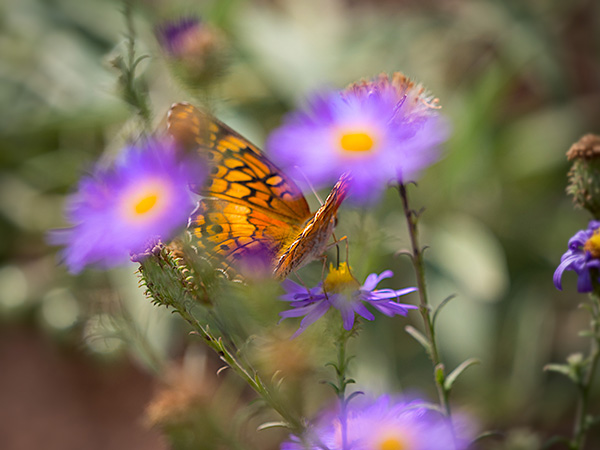
by successfulbob | bird photography, flower photography, Lumix G9, photo walkabout, photography, photography gear, wildlife photography
Long Lens Photography – 100-400mm
I enjoy my long lens for outdoor photography. It’s a beautiful piece of equipment for isolating subjects against a background with nice bokeh. The longer the lens, the easier it is to have an out-of-focus background. The PANASONIC LUMIX G Leica DG Vario-Elmar Professional Lens, 100-400MM, F4.0-6.3 ASPH is a magical lens IMHO.
Here are some images from a walkabout at the Sedona Wetlands. I didn’t find many waterfowl as it was midday and possibly the wrong time of year. In any case, I always try to make the best of any photography situation and started looking for details. There are still some wildflowers scattered throughout. This attracts butterflies, birds, and bees.
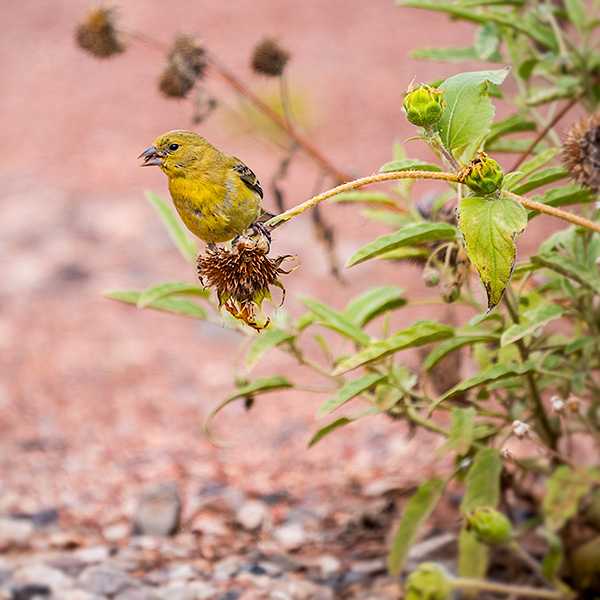 Adult female Lesser Goldfinch snacking on some wildflowers that have gone to seed
Adult female Lesser Goldfinch snacking on some wildflowers that have gone to seed
 I always look to capture ‘behavior’ photos as well as straight portraits of my feathered friends. Here the Lesser Goldfinch is working to get the seeds free from the plant.
I always look to capture ‘behavior’ photos as well as straight portraits of my feathered friends. Here the Lesser Goldfinch is working to get the seeds free from the plant.
 Butterfly caught with shallow depth of field between the plants.
Butterfly caught with shallow depth of field between the plants.
The butterfly photo was my favorite photo of the day. If you’ve chased butterflies in the wild, you know how difficult it can be to get an interesting image. I tracked this one for a while and looked to ‘sandwich’ the butterfly with DOF. I wanted a sharp subject surrounded by the in and out of focus flowers. This was made more difficult as there were not a ton of flowers in bloom and the wind was making the flowers dance as well. Now that I see the image here I’ll crop in a little tighter and loose the past prime flowers on the right-hand side of the photo.
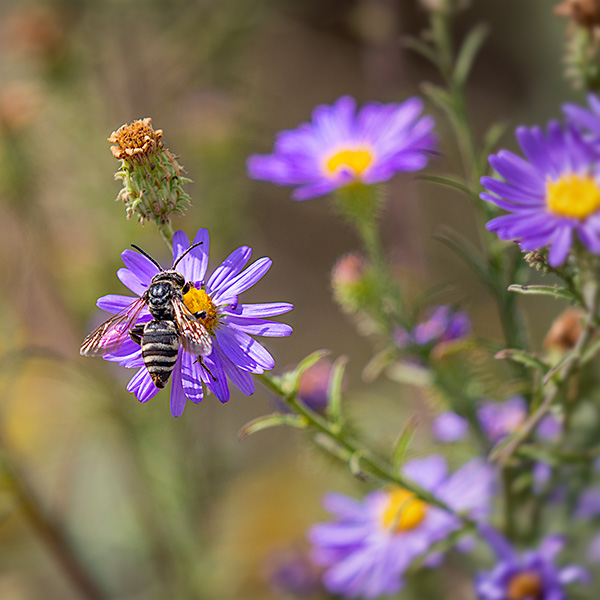 Wasps one of our other pollinators were flitting between the blooms as well as the butterflies.
Wasps one of our other pollinators were flitting between the blooms as well as the butterflies.
I choose this one to share as it has a different color with black and white stripes.
Back to the lens. One complaint I hear about the lens is that it is very stiff to zoom. It was designed that way not to suffer ‘lens creep’ when you hang it from your shoulder. I’ve found a perfect way to change the zoom. Instead of trying to turn the lens, hold the lens and turn the camera. It’s like opening a bottle of champagne where you hold the cork and twist the bottle. Makes it easy and you don’t end up with the lens creep!
When paired with the Lumix G9 you get 6 and a half stops of handholdability. All images were handheld in this post.
Yours in Creative Photography, Bob
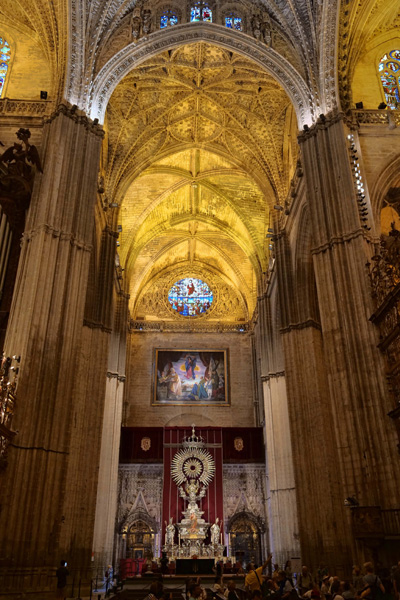
by successfulbob | architectural photography, Guest Post, Lumix G9, travel photography
Seville Spain – Travel with Ken MacAdams
Ken shares his travel photography and stories here on Successful-Photographer as he has in the past. Ken’s camera of choice is Panasonic’s flagship stills camera the Lumix G9 with the Leica DG Vario-ELMARIT Professional Lens, 12-60MM, F2.8-4.0
Seville shines as one of Spain’s magnificent stars. Activities include attending a bullfight, standing in awe at the immensity of the world’s largest Gothic church, or going shoulder to shoulder with the crowds in the Reales Alcazar, a beautiful Moorish style palace. In the 16th century, Seville was the gateway to the New World. Explorers Vespucci and Magellan sailed from its great river harbor, discovering new trade routes and abundant sources of gold, silver, cocoa, and tobacco. In the 17th century, it was Spain’s largest and wealthiest city.
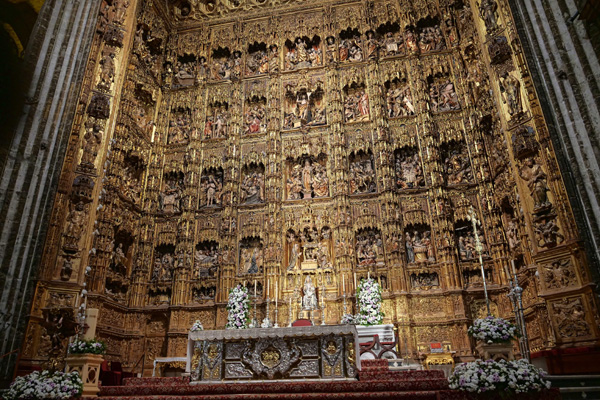 Protected by a Renaissance wrought-iron grill, it was impossible to stand on-center of the High Altar to photograph this 65 foot tall altar. All Photos in this post © Ken MacAdams
Protected by a Renaissance wrought-iron grill, it was impossible to stand on-center of the High Altar to photograph this 65 foot tall altar. All Photos in this post © Ken MacAdams
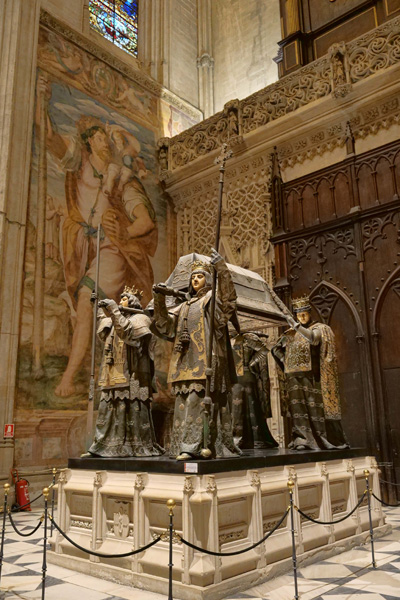 The tomb of Christopher Columbus is carried by four kings.
The tomb of Christopher Columbus is carried by four kings.
Seville’s Cathedral is the third largest church in Europe. It rises from the site of a mosque that was torn down in 1401 to make way for the cathedral, one that the Reconquista Christians said would be the largest in the world. Past the immense pipes of the church’s pipe organ is the High Altar, protected by a wrought-iron Renaissance grille. Standing 65 feet tall, there are 44 scenes from the life of Jesus and Mary, all carved from walnut and chestnut – blanketed by a staggering amount of gold leaf.
 In this image you can see the immense floor to ceiling scale of the church. Set on AWB, the Lumix G9 was able to correctly register the different color tones of the interior lighting.
In this image you can see the immense floor to ceiling scale of the church. Set on AWB, the Lumix G9 was able to correctly register the different color tones of the interior lighting.
The work, finished in 1564, took three generations to complete. Opposite from the Altar de Plata, is the Tomb of Columbus. Located in front of the cathedral’s entrance for pilgrims are four kings who bear the remains of Christopher Columbus upon their shoulders. Identified by their team shirts, the pallbearers represent the regions of Castile, Aragon, Leon, and Navarre. A walk through the Treasury reveals gold and silver reliquaries, and Spain’s most valuable crown, the jeweled Corona de la Virgen de los Reyes. Attached to the church is the Giralda Bell Tower, a former minaret. If you have the time – or energy – you can climb the 330 feet up to its top for a grand city view.
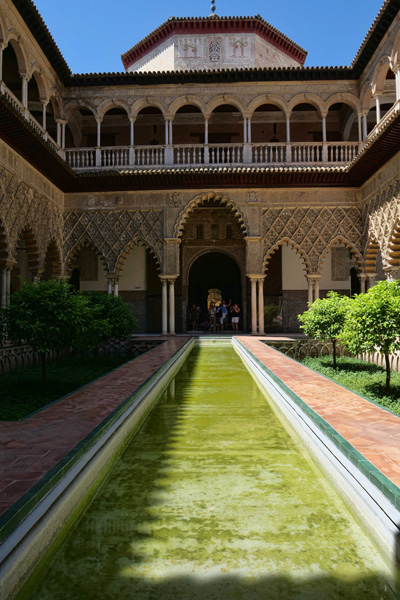 The pool within the courtyard served a dual purpose – besides beauty, it helped cool the surrounding rooms of the palace during the hot summer days.
The pool within the courtyard served a dual purpose – besides beauty, it helped cool the surrounding rooms of the palace during the hot summer days.
Look for more on Seveille, Spain and the Royal Alcazar from Ken next Friday!
Ken has always loved to travel, so when he made a common connection with the fact that either a long day pounding the streets of some foreign city, or shooting the last dance at a wedding, a good part of his physical

weariness came from lugging around his big heavy DSLR. That’s when he started looking at alternatives – and ended up selecting Panasonic Lumix Micro Four Thirds gear.
Ken is rarely without a camera, and the next great photo travel experience – whether local or abroad – is always in the back of his mind! A longtime resident of the Four Corners, and when he’s not out on the road, he enjoys some of the great outdoor opportunities found there – mountain biking, hiking, and Jeeping.

 Dunlin Sandpipers enjoying breakfast
Dunlin Sandpipers enjoying breakfast Thought this was an interesting formation of the Canada Geese. I normally enjoy them mor eisolatedbut the overlap of the birds is kida cool. Watcha’ think??
Thought this was an interesting formation of the Canada Geese. I normally enjoy them mor eisolatedbut the overlap of the birds is kida cool. Watcha’ think?? A simple houe wren was dancing in and out of the flowering bush. Behavior and movement photos are my aim.
A simple houe wren was dancing in and out of the flowering bush. Behavior and movement photos are my aim.



























